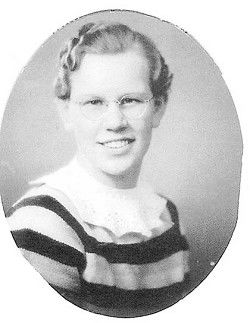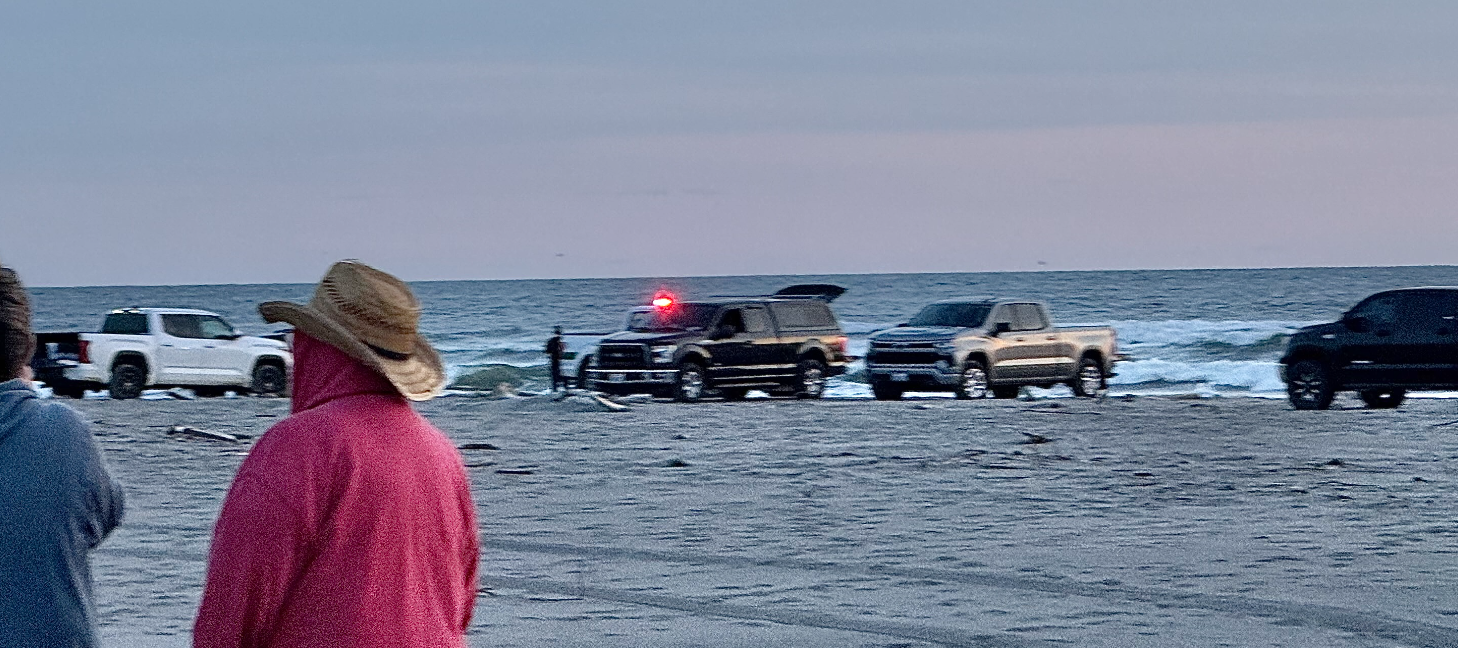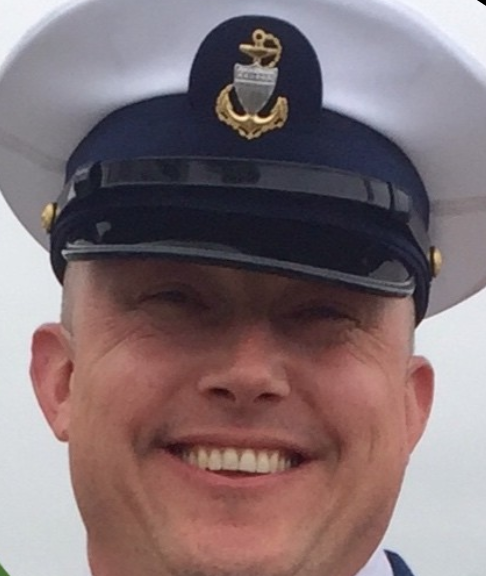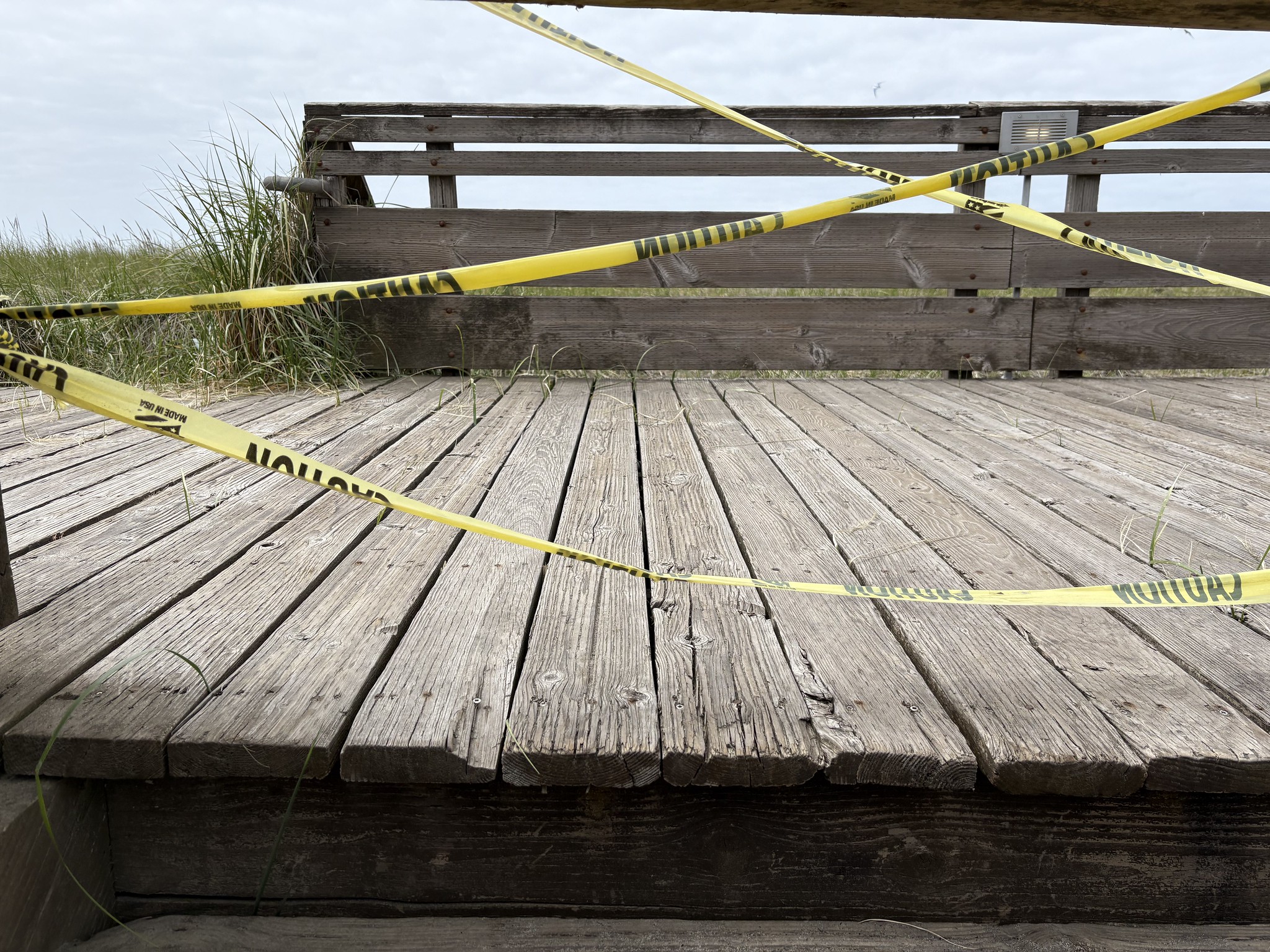The Chellis Sisters: Frances Chellis Church & Lorna Chellis Holeman
Published 4:00 pm Tuesday, February 6, 2007

- <I>Arlene Barber Collection</I><BR>Lorna Chellis in high school, circa 1935, wearing a sweater she had knitted, perhaps while doing her Latin homework.
North Beach GirlsOf the teens and ’20sIn the 1910s and 1920s, the North Beach Peninsula, as it was then called, was still very much isolated from the mainstream world beyond. Although, electricity, automobiles and radios were coming into everyday use elsewhere, our area was still a backwater – “the jumping off place” some said. We are fortunate to have, among our older residents, many who grew up here and stayed or, perhaps, grew up here, left for a time, and moved back. In this series, Sydney Stevens talks to “The North Beach Girls of the Teens and Twenties” to capture their precious memories of growing up on the Peninsula almost a century, almost a lifetime, ago.
The pivotal event in the childhood of sisters Lorna and Frances Chellis occurred on Thursday, Feb. 5, 1931. That was the day their father drowned in Willapa Bay. Lorna would be 12 in exactly two weeks; Fran would be nine, eight days after that.
Lorna remembers that it was a clear, calm day in Ocean Park – the kind of day which is frequently typical of February weather on the Peninsula. “My mother had kept me home from school that day to do some special errands for her,” she says. “In the afternoon my father drove his Model T over to the dock in Nahcotta, as he often did, to do some work on his boat. There were other men working there, too, and about the time they all got ready to call it a day, my dad took Ed’s dinghy out to check on his crab pot.
“Ed was our oldest brother and he, along with the next oldest brother, Walt, were seniors in high school. They were in the same class even though Ed was a year older than Walt. The year Ed was a freshman there hadn’t been a bus to the high school and we couldn’t afford for him to ride the train. So he stayed out a year. The next year there was a bus and he and Walt both began high school together.”
“Anyway,” she says as she picks up the thread of her story, “I think it was the year he was home that Ed had built a boat, a skiff. My dad was a crabber and a few days before he drowned, he’d taken the skiff out to sink a crab pot. He wanted to see if the crabs were ‘in’ yet. That Thursday when he left the dock to check out the crab pot was the last anyone ever saw of him.”
Fran remembers that the family stayed up late that evening awaiting their father’s return. “He was always home by eight o’clock, but that night he didn’t come and he didn’t come. Finally, Mother sent Ed and Walt down to the dock to see what the problem was. I think probably the Loomis boys and maybe Alfred Garretson went with them.
“She let the rest of us stay up until we saw the headlights of two rigs coming toward the house. Of course, we all thought it was dad and Mother told us to get to bed quick or he would be mad. It wasn’t until the next morning that we children learned that he had drowned.” The memory still brings tears and she pauses a bit, remembering.
The boat was found with the crab pot in it and the oarlocks inside the crab pot, all tangled up. It was seven long weeks before Walter Chellis’ body was found. He was 48 years old and left seven children and his widow, Mable, pregnant with their eighth child. Lorna was third oldest, after Ed and Walt. Then came Betty, Frances (“Fran”), Josephine, Allen and, in May, Mary.
“Of course, in those days there was no welfare or social security,” Lorna remembers. “It was difficult for a big family like ours.”
“The county did give Mother a check for $40 every month – $5 for each of us eight children,” adds Fran. “A widow’s pension they called it. However, all those checks bounced. It was the Depression and not even the county had money. I remember that Mr. Louis Loomis, who lived here in Ocean Park, bought each check from Mother for cash to help us out. When things were better, the county made good on the checks. They paid Mr. Loomis full value plus interest. I heard Mother say once that she wished she could have hung on to them, but of course she couldn’t.
“The school people suggested that Ed and Walt quit so they could go to work full time, but Mother wouldn’t hear of it. They only had a few months left before graduation and so they stayed in school.”
“Within two weeks, though, Mr. Pearson gave Ed a job at his store,” Lorna recalls. “He worked after school and on weekends and then went to work full time after he graduated. He always put his paycheck towards our bill at the store. Mama had a lot of hens and so she gave eggs to the store against our bill but whatever was left owing Ed paid out of his paycheck. Mama had a big garden, too, which helped feed the family. And, fortunately, we had the laundry. As soon as we were old enough, we all worked. My mother worked the hardest of all.”
At almost 12, Lorna was already experienced in the work world. The summer she was 10 she had gone to work for Mrs. Parant who lived several blocks away. “She was in a wheelchair,” Lorna recalls, “and I was hired to do light housework – dusting and sweeping. I also peeled the potatoes and got things ready for dinner, but I didn’t cook. And I helped Mrs. Parent by getting things for her – her sewing basket, for instance. I made a dollar a week.”
Halfway through the summer, Mr. Chellis determined that Lorna would be of more value working in the laundry, so she quit her job for Mrs. Parant and went to work in the family business. She hung out the wet laundry, took it off the line when it was dry and, on Thursday evenings, when her father used the mangle to press the sheets, she folded and got the laundry ready for delivery on Friday.”
“We took the wet clothes from the laundry to the clothesline in a wheelbarrow,” remembers Fran. “Over the years, we wore out several barrows. Of course, when the clothes were dry they weighed less and we could carry them back in laundry baskets. Lorna was the best hand ironer,” Fran says with admiration. “She was really fast at ironing shirts and later, when she was at Walla Walla College, she paid her way by ironing men’s shirts and working in the college laundry.
“I was the runner,” she continues. “I was very fast, and on Fridays I would run all over town delivering the bundles of finished laundry. Most people dropped off their dirty clothes on Mondays but, if they didn’t show up by the time school was out on Tuesday, I’d go and collect it.
“I sorted and weighed and helped to hang the laundry on the clotheslines, too. We had 30 lines, each about 25 or 30 feet long. We also had a ‘dryer’ that my father had made,” Fran says with a twinkle in her eye. “It was a shed with a wood stove and several clotheslines in it. But we hung the clothes outside unless it was raining. In the winter we had to be fast or the clothes would freeze in the wheelbarrow before we could get them on the line!”
The laundry building, at first, was just a shed to hold the washing machine and a lean-to for the pump. “Dad found a huge barrel on the beach,” says Fran. “He set it up on a framework with pipes coming from the firebox and more pipes going into the laundry. Even in later years we heated the water that way. No one had electric water heaters.”
Lorna remembers that Fran was the one who looked after the younger children while their mother worked. “I guess that’s right,” agrees Fran. “But it didn’t stop me from hanging laundry. The little kids could sit on the ground under the clotheslines with their toys while I worked. That way I could keep an eye on them.”
Lorna smiles as she tells how the Chellis family got into the laundry business in the first place. “About 1928, my folks decided to buy an electric washing machine – a Maytag. They already had a big family and I suppose our old washing machine had given out. They bought the electric one on time payments. I don’t know how much the payments were, probably only 10 dollars or so a month. But money was scarce, so they decided to go into the laundry business to pay for the washing machine!”
The Chellis Laundry was a fixture in Ocean Park for the next quarter century. The Chellis name became so much a part of the Ocean Park community that it seemed the family had always been there.
“But,” says Lorna, “we didn’t move here until I was almost six years old and Fran was nearly three. We were both born in Calipatria, Calif. We all were born in California, except for the last three. My father must have been somewhat of an adventurer. He was from the Portland area, went to Nome during the Alaska gold rush, and somehow ended up in California.”
Continuing the story, Fran says, “In those days, there wasn’t all the mechanized equipment and safety gear that they have now. Dad was an architectural engineer and was supervising on a job when the rope broke on a load of windows being hoisted to a top floor. He was badly hurt and couldn’t work, so we went to stay with relatives for awhile.”
“We moved up to the Northwest and lived with my grandparents in Hazel Dell for six months,” explains Lorna. “My father’s uncle, Al Rushlight, had a summer place in Ocean Park and he just gave my folks the keys. He also bought Dad a crab boat so he could get into that line of work.
“The main thing I remember about getting to the Peninsula is that all of us kids worried that we wouldn’t make the last ferry,” laughs Lorna. “That was important. With a large family, it wouldn’t have been easy to find a place to stay on the other side of the river. There were five children by then. The next three were born here after we moved here.”
Within a year or two of their arrival in Ocean Park, the Chellis family bought eight of the 12 lots in the block bounded by today’s streets, Ridge and “R” to the west and east, and 262nd and 263rd to the south and north – close to the area where the Peninsula Assembly of God church stands today.
“Dad’s idea was to build three small houses that could be rented out eventually, and then he planned to build a big house for the family. He died before he could get started on the big house, so we just used the small ones. That is where we began the laundry,” says Lorna.
Soon, they were also renting four lots directly north to use for the garden and clotheslines. Later, Ed built a little house on that property and lived there until shortly before he was married.
“Dad was a good carpenter. He built all of our houses and the laundry building,” Lorna remembers. “The laundry was just two by fours and cedar shakes.”
“Yes,” Fran agrees, “but he was California-trained and his roofs were almost flat. For that reason, the houses all leaked in the winter. Everyone told him to build pitched roofs but he was stubborn. He finally put a slight angle to the roof of the third house – not too much, though; he didn’t like to admit he’d been wrong!”
The third house was a little larger than the other two and the Chellis sisters refer to it as “Mother’s house.” It was still unfinished inside when Walter Chellis drowned so their grandfather came in the summer and completed it – another memory that brings tears to Fran’s eyes. “Imagine!” she says. “He was 85 years old and still could do that hard work. And beautifully, too!”
“Mother slept there with the baby. We ate there and did our homework there but there wasn’t room for all of us to sleep there, so we used one of the other little houses for our bedrooms. In the summer we slept out on the porch,” says Fran.
In Lorna’s memory, there wasn’t much time for play. “With our big family, all of our activities centered around our house and the laundry. I always came right home from school to help Mama, even when I was in high school.”
Fran agrees that there wasn’t time to go visiting but their friends did come to the Chellis place to play. “Jane Pearson (Whitten) and Ellen Loomis (McMurray) were about my age. The Yeager kids would come to play, too. They would follow me around while I was hanging clothes but they never did help me deliver!
“Dad had built us a cute playhouse, all shingled, except it didn’t have a door. We played there and we played a lot of running games like Run, Sheep, Run. In the summer time we’d have a bonfire every night about 10 o’clock. We’d roast marshmallows and have a fine time.”
Another of Fran’s memories of her father is that he was strict. “When we didn’t obey or got sassy he would have us go cut a switch and then we would get it! One time,” she smiles, “Betty was in trouble for something and when she was sent for a switch she came back with one of those big old floppy ferns. Then she really got it! Mother disciplined us, too, but not with a switch. She used dad’s razor strap and it hung right where we could see it, as a warning. But it didn’t sting like the switch did. After dad died, Ed (as the oldest) was also given permission to discipline us. In many ways he was like a second father to us kids.”
“Summer was when we were busiest,” says Lorna. “Families came to Ocean Park to stay for the season. Most didn’t have electricity or even washing machines in their summer places, so the laundry was very necessary for them. Mama did the laundry for Miss Elliot’s summer camp, too. Of course, we had some loyal year-round customers so even in the winter the laundry kept going.”
Fran recalls that the winter was hard on the year-round residents. “There was water everywhere. Lots of Ocean Park has been filled since then; the hills have been graded and there are drainage pipes under the roads. But I can remember the water coming right up around the buildings in the winter. And I remember how we had to get from our house to the boardwalk that went along Bay Avenue into Nahcotta. That was the way we walked to school. To get to the boardwalk, we had to jump from hummock to hummock to stay out of the water.”
Both girls went to Nahcotta School and then on to Ilwaco High School. “But I didn’t graduate from Nahcotta School,” says Fran with a smile. “And not from Ocean Park either. Nahcotta School burned in January of my eighth grade year and I finished the year out at the Ocean Park Methodist Church.
“I remember the night the school burned. It was in the evening in January so it was already dark and we could see the flames and the glow in the sky from Ocean Park. Mother let us go to watch – going somewhere late like that was unheard of! It was a big event for all of us children.”
By that time, Lorna was away at college, Walt had joined the CCC and Ed was into the grocery business. Before long he purchased Clark & Company – the very store on Bay Avenue that had been owned by Mr. Pearson when Ed began working there in 1931. Under his ownership, it became Ed’s Grocery. It was located where the Dunes Restaurant is today.
Fran smiles as she remembers, “Whenever I had a nickel I would go into Ed’s store and buy fig bars. I could get a dozen for five cents! A nickel went a long ways in those days. Betty would save up until she had 10 cents – enough for a Big Hunk candy bar, but Mother wouldn’t let me get those because of my teeth. My favorite candy was Walnettos but they were so chewy they pulled out my fillings.
“I had terrible teeth. When I came along, Mother’d had three kids in three years and no one knew about taking vitamin supplements then, so my teeth were the worst! When I had a dental appointment, I rode the high school bus with Lorna and went to class with her. She’d tell me when I had to leave to get to the dentist on time. His office was above Doupé’s. Then I’d go back to her class and sit there until school was out. The teacher didn’t mind as long as I kept my mouth shut. I think that must have been hard for me,” she laughs. “I’ve always liked to talk.”
An important event of Lorna’s growing-up years was the discovery that she needed glasses. “I think I was a freshman when I was first fitted with glasses. I hadn’t realized how near sighted I was. I really couldn’t tell from my seat whether the teacher’s arms were at her sides or behind her back or even if she had her hands at her waist with her elbows sticking out!”
“Lorna was a good student,” says Fran. “I remember her pulling her chair up to the kitchen stove while she studied her Latin and knitted. She knitted beautifully. I remember three of the outfits she knitted herself in college. I admired her so much!”
Both Lorna and Fran remember the kindness of neighbors and friends. “Mr. Yeager always helped Mother if she had any wiring or plumbing problems. I don’t know how he had the time; he had a family about as big as ours,” says Fran. “And then there was Mrs. Millspaugh who brought her laundry in on Tuesdays and would stay all day to help Mother with the wash. Our aunt came from Portland in the summer and helped, too.”
Another bit of neighborliness that Fran remembers is how store owners expressed their appreciation to customers. “I still have a bowl that the Doupés gave me for a wedding present! And when you paid your bill, most stores gave bananas or oranges or some treat that was hard to come by. Mother gave flowers to her best customers. She had flowers all around the vegetable garden and, of course, the summer people didn’t have gardens. People were just more caring then. Of course,” she adds wistfully, “there were fewer people here then. We knew almost everybody.”





